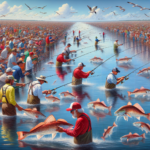Yellowfin Tuna Tournament in the Gulf of Mexico
Introduction
Did you know that the Gulf of Mexico is home to one of the most exciting and competitive fishing tournaments in the world? The Yellowfin Tuna Tournament attracts anglers from all over, eager to test their skills and reel in these powerful fish. This article will delve into the intricacies of the Yellowfin Tuna Tournament in the Gulf of Mexico, covering everything from fishing techniques and species information to the best fishing spots and preparation tips for the event.
Whether you’re a seasoned angler or a novice looking to get into the sport, understanding the nuances of this tournament can significantly enhance your experience. From mastering the right techniques to knowing the best times and places to fish, this guide will provide you with all the information you need to make the most of your fishing adventure.
Background/Context
Historical or Cultural Significance
The Yellowfin Tuna Tournament has a rich history that dates back several decades. Initially started as a local competition among fishing enthusiasts, it has grown into a major event that attracts participants from around the globe. The tournament not only celebrates the sport of fishing but also highlights the cultural and economic importance of the Gulf of Mexico’s marine ecosystem.
Geographical Overview
The Gulf of Mexico is a vast body of water bordered by the United States, Mexico, and Cuba. Known for its warm climate and diverse marine life, the Gulf provides an ideal habitat for Yellowfin Tuna. The region’s topography includes deep waters, coral reefs, and underwater canyons, making it a prime location for big-game fishing.
Key Points/Details
Fishing Techniques
Technique Overview
When it comes to catching Yellowfin Tuna, several techniques are commonly used. These include trolling, chunking, and live bait fishing. Trolling involves dragging lures or baited hooks behind a moving boat, while chunking uses pieces of bait to attract tuna to the boat. Live bait fishing, as the name suggests, uses live fish to lure in the tuna.
When and Where to Use
Trolling is most effective in open waters where tuna are likely to be swimming near the surface. Chunking is best used when you have located a school of tuna, as it helps to keep them near your boat. Live bait fishing can be used in various conditions but is particularly effective when targeting larger tuna.
Recommended Gear
- Rods: Heavy-duty rods capable of handling large fish.
- Reels: High-capacity reels with strong drag systems.
- Lines: Braided lines with high tensile strength.
- Bait/Lures: Live bait, artificial lures, and chunk bait.
Species Information
Species Overview
Yellowfin Tuna (Thunnus albacares) are known for their speed and strength, making them a prized catch among anglers. They are typically found in warm, deep waters and are known to migrate long distances. Yellowfin Tuna can grow up to 400 pounds, although the average catch in the Gulf of Mexico is usually between 50 to 150 pounds.
Best Practices
To successfully catch Yellowfin Tuna, it’s essential to use the right techniques and gear. Trolling with artificial lures can be effective, especially during the early morning or late afternoon when tuna are more active. Using live bait can increase your chances of attracting larger fish. It’s also crucial to be patient and prepared for a long fight, as Yellowfin Tuna are known for their endurance.
Location Information
Top Fishing Spots
- Venice, Louisiana: Known as the “Tuna Capital of the World,” Venice offers some of the best Yellowfin Tuna fishing in the Gulf.
- Destin, Florida: Another popular spot, especially during the summer months when tuna are more abundant.
- Port Aransas, Texas: Offers excellent fishing opportunities, particularly in the fall.
Regulations and Licenses
Before heading out, make sure to check local fishing regulations and obtain the necessary licenses. The Gulf of Mexico has specific rules regarding catch limits, size restrictions, and seasonal closures to ensure sustainable fishing practices. It’s essential to stay updated on these regulations to avoid any legal issues.
Seasonal Considerations
Seasonal Variations
Fishing conditions in the Gulf of Mexico can vary significantly throughout the year. During the summer months, Yellowfin Tuna are more likely to be found near the surface, making trolling an effective technique. In the winter, they tend to move to deeper waters, requiring different strategies such as chunking or live bait fishing.
Best Times to Fish
The optimal time for Yellowfin Tuna fishing in the Gulf of Mexico is from late spring to early fall. During this period, the water temperature is ideal, and tuna are more active. Early morning and late afternoon are generally the best times of day to fish, as tuna are more likely to be feeding.
Events and Tournaments
Event Overview
The Yellowfin Tuna Tournament is typically held in the summer, with various locations across the Gulf of Mexico hosting the event. Participants compete for prizes based on the size and number of tuna caught. The tournament not only offers a chance to showcase fishing skills but also provides an opportunity to connect with other anglers and enjoy the camaraderie of the fishing community.
Preparation Tips
- Gear Check: Ensure all your equipment is in top condition, including rods, reels, and lines.
- Practice: Spend time practicing your techniques to increase your chances of success during the tournament.
- Strategy: Develop a game plan based on the specific conditions and locations of the tournament.
Tips and Best Practices
General Tips
- Stay Informed: Keep up-to-date with weather conditions and water temperatures.
- Be Patient: Fishing for Yellowfin Tuna can require long hours and persistence.
- Work as a Team: If fishing with others, coordinate your efforts to increase efficiency and success.
Avoid Common Mistakes
- Overloading Gear: Ensure your gear is appropriate for the size of fish you’re targeting.
- Ignoring Regulations: Always adhere to local fishing laws and regulations.
- Underestimating Conditions: Be prepared for changing weather and water conditions.
Advanced Techniques
- Kite Fishing: Using a kite to suspend bait on the water’s surface can be highly effective for attracting Yellowfin Tuna.
- Deep Dropping: This technique involves dropping bait to deeper waters where larger tuna may be lurking.
- Chumming: Releasing a mixture of bait and fish parts into the water to attract tuna to your location.
Gear and Equipment Recommendations
Essential Gear
- Heavy-Duty Rods: Capable of handling large, powerful fish.
- High-Capacity Reels: With strong drag systems to manage long fights.
- Braided Lines: High tensile strength lines to withstand the force of a Yellowfin Tuna.
- Live Bait and Lures: Essential for attracting and catching tuna.
Optional Gear/Upgrades
- Fighting Belts: To provide support during long battles with large fish.
- Fish Finders: Electronic devices to locate schools of tuna.
- Kite Fishing Kits: For advanced techniques to attract tuna.
Where to Buy or Rent
Local fishing shops in areas like Venice, Louisiana, and Destin, Florida, offer a wide range of gear for purchase or rent. Online stores such as Bass Pro Shops and Cabela’s also provide extensive selections of fishing equipment suitable for Yellowfin Tuna fishing.
Safety and Conservation
Safety Tips
- Weather Awareness: Always check weather forecasts before heading out and be prepared for sudden changes.
- Life Jackets: Ensure all passengers wear life jackets, especially in rough waters.
- First Aid Kit: Keep a well-stocked first aid kit on board for emergencies.
Conservation Practices
- Catch and Release: Practice catch and release to help maintain fish populations.
- Respect Regulations: Adhere to local fishing laws and regulations to promote sustainable fishing.
- Avoid Overfishing: Be mindful of catch limits and avoid taking more fish than necessary.
Planning Your Trip
Accommodations
There are numerous lodging options near popular fishing spots in the Gulf of Mexico. In Venice, Louisiana, you can find fishing lodges and hotels that cater specifically to anglers. Destin, Florida, offers a range of accommodations from beachfront resorts to budget-friendly motels.
Travel Tips
- Best Routes: Plan your route in advance and consider traffic conditions, especially during peak fishing seasons.
- Transportation: If you’re flying, check airline policies on transporting fishing gear. Renting a car can provide flexibility for exploring different fishing spots.
Additional Activities
If you’re traveling with family or friends who aren’t as interested in fishing, there are plenty of other activities to enjoy in the Gulf of Mexico region. From beach outings and water sports to exploring local cuisine and cultural attractions, there’s something for everyone.
Frequently Asked Questions (FAQs)
What is the best time of year to fish for Yellowfin Tuna in the Gulf of Mexico?
The best time to fish for Yellowfin Tuna in the Gulf of Mexico is from late spring to early fall, with peak activity during the summer months.
Do I need a special license to participate in the Yellowfin Tuna Tournament?
Yes, you will need a valid fishing license for the state where the tournament is held. Additionally, some tournaments may have specific entry requirements or fees.
What type of bait is most effective for catching Yellowfin Tuna?
Live bait such as sardines or mackerel is highly effective for catching Yellowfin Tuna. Artificial lures and chunk bait can also be successful.
Are there any size or catch limits for Yellowfin Tuna in the Gulf of Mexico?
Yes, there are size and catch limits to ensure sustainable fishing practices. These regulations can vary by state, so it’s essential to check local laws before fishing.
Conclusion
The Yellowfin Tuna Tournament in the Gulf of Mexico offers an exhilarating experience for anglers of all skill levels. By understanding the best fishing techniques, knowing where and when to fish, and being well-prepared with the right gear, you can maximize your chances of success. Remember to prioritize safety and conservation to ensure that future generations can enjoy this incredible sport. Whether you’re participating in the tournament or simply looking to catch some Yellowfin Tuna, this guide provides all the information you need for a successful fishing adventure.
So, gear up, stay informed, and get ready to reel in some impressive Yellowfin Tuna in the beautiful waters of the Gulf of Mexico!


